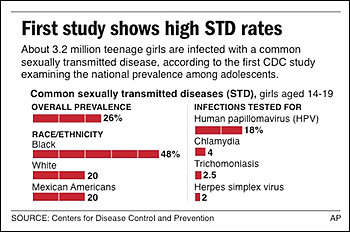We are in the age of technology, and the use of technology does not exclude sex. It is very important to educate your children about sex and technology. Facebook and My Space are two of the most popular blog sites, and are growing more are more popular among our youth. For the most part these sites are simply a way to social network, but it is important to note that sometimes there are more to these sites than just fun and games. It is important to monitor what you kids are putting on these sites, as well as whom they are communicating with. Sexual predators hangout on these sites and your kids need to be aware of this. According to USA Today, “MySpace says about 90,000 sex offenders have been identified and removed from its huge social networking website.” (USA TODAY).
Not only are social networking sites a place of concern, but cell phones are now being used as tools of sex. Text messaging is becoming more and more popular, as well as more advanced. We are able to send pictures and videos via text messages. This is a great technology but it is also one that can be dangerous. Teens engage in what we have come to call sexting. It is the term used to define sending sexual content to someone via text message. This includes both nude and semi-nude photos along with sexually explicit language. According to a survey conducted by The National Campaign to Prevent Teen and Unplanned Pregnancy, almost 40% of teens send sexually explicit messages, and 20% of teens send nude or semi-nude photos of themselves via texting. With more of these teens being girls.
It is important to remind your teens of the actuality of the situation. They need to know that doing this is not a joke, and it can have some pretty serious consequences. The website (http://www.thenationalcampaign.org/sextech ) gives us a list:
FIVE THINGS TO THINK ABOUT BEFORE PRESSING SEND
1. 1. Don’t assume anything you send will remain private.
-People send these messages with the intention of the having it only be read by the receiver, however this is not true.
2. 2. There is no changing your mind in cyberspace. Anything you send or post will never truly go away.
-Even after something is deleted, it still has the potential to be uncovered. Parents, coaches, teachers, future employers, colleges, all have to potential to uncover these. And more importantly, even if a picture is deleted, there is no telling if someone copied it and released it elsewhere.
3. 3. Don’t give into the pressure to do something that makes you uncomfortable, even in cyber spae.
-A lot of teens “sext” because they feel pressured to do so.
4. 4.Consider the recpiant’s reaction.
-Teen girls often send these messages as a joke, but the boys who receive them do not see them as a joke, and many expect the girls to hook up with them in real life.
5. 5. Nothing is truly anonymous.
-Nearly 1/5 of teens who send sexually explicit messages online do so to someone they only know online. But it is important to remember, if someone wants to find out who you are badly enough, they will.
While this is pretty scary to think about, the question is how do I stop my teen from engaging in this activity. And no the answer is not to take away all the technology from them. You need to communicate your concerns about this with your kids, and you need to share the dangers with them. They need to be aware of them. I have borrowed some tips from The National Campaign to Prevent Teen and Unplanned Pregnancy.
5 TIPS TO HELP PARENTS TALK TO THEIR
KIDS ABOUT SEX AND TECHNOLOGY”
1.Talk to your kids about what they are doing in cyberspace.
-Just as you need to talk openly and honestly with
your kids about real life sex and relationships,
you also want to discuss online
and cell phone activity. Make sure your kids fully understand
that messages or pictures they send over the Internet
or their cell phones are not truly private or anonymous.
Also make sure they know that others might forward their
pictures or messages to people they do not know or want
to see them, and that school administrators and employers
often look at online profiles to make judgments about potential
students/employees. It’s essential that your kids grasp
the potential short-term and long-term consequences of
their actions.
2.Know who your kids are communicating with.
Of course it’s a given that you want to know who your children
are spending time with when they leave the house. Also
do your best to learn who your kids are spending time with
online and on the phone. Supervising and monitoring your
kids’ whereabouts in real life and in cyberspace doesn’t make
you a nag; it’s just part of your job as a parent. Many young
people consider someone a “friend” even if they’ve only met
online. What about your kids?
3.Consider limitations on electronic communication.
-The days of having to talk on the phone in the kitchen in
front of the whole family are long gone, but you can still limit
the time your kids spend online and on the phone. Consider,
for example, telling your teen to leave the phone on the
kitchen counter when they’re at home and to take the laptop
out of their bedroom before they go to bed, so they won’t be
tempted to log on or talk to friends at 2a.m.
4.Be aware of what your teens are posting publicly.
-Check out your teen’s MySpace, Facebook and other public
online profiles from time to time. This isn’t snooping—this is
information your kids are making public. If everyone else can
look at it, why can’t you? Talk with them specifically about
their own notions of what is public and what is private. Your
views may differ but you won’t know until you ask, listen, and
discuss.
5.Set expectations.
-Make sure you are clear with your teen about what you consider
appropriate “electronic” behavior. Just as certain clothing
is probably off-limits or certain language unacceptable
in your house, make sure you let your kids know what is and
is not allowed online either. And give reminders of those expectations
from time to time. It doesn’t mean you don’t trust
your kids, it just reinforces that you care about them enough
to be paying attention.
Like we always stress, the more you talk to you kids, the more you will be able to talk about. They will feel more comfortable coming to you with questions and concerns they have.
REFRENECES:
MySpace: 90,000 sex offenders removed from site – USATODAY.com
Sex and Text: Results from a survey of teens and young adults. http://www.thenationalcampaign.org/sextech



 Posted by parentchild
Posted by parentchild 
